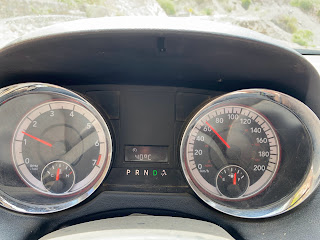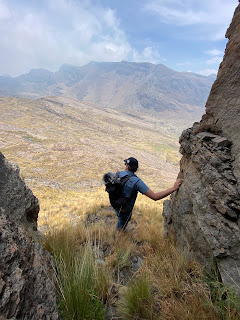 |
| Are we in Arches National Park? |
November 7th – Fingers Crossed
It was a little surreal to be
finally leaving La Paz and hard to say goodbye to the community we had made,
but thanks to them, among others we had met in La Paz, our saga of vehicle
issues and health problems was still, all things considered, a positive moment
within our trip.
 |
| The coolest hot showers we've ever had! |
We left as early as we could
bring our selves to leave and after our final goodbyes we started our journey
towards our next must-do stop in Bolivia; Toro Toro National Park. According to Google it was going to take us
10 hours and although we had enough road snacks and podcasts to keep happy,
after 8 hours on the road we were done.
Thankfully that brought us to the 3rd largest city in
Bolivia, Cochabamba.
 |
| Rupert's new friend |
The campground in Cochabamba was
perfect. We knew we had made the correct
decision to stop when we saw the toilets and outdoor shower the belonged in a
high-class resort and pet llamas beside us with a temperature in the low 20s at
night. The place seemed like
paradise. As we set up for the night
Paul diligently checked the vehicle hoping that everything was as it should be,
and to our delight the van was running perfectly.
November 8th – A descent
we will not forget
 |
| Laguna Mal Paso |
The first must-do activity
was to hike to Laguna Mal Paso within Tunari National Park. The National Park is “only” 14 kilometres
from the campground but the drive is almost double the amount of kilometres and
it goes up a long and windy road into the mountains. We felt like we were on a
forestry road in BC, surrounded by pine trees on an unpaved road. The drive
took us more than an hour to complete and brought us to a high elevation
lake. We weren’t 100% sure how to get to
Laguna Mal Paso but, based on google and some old llama paths we charted a
route.
 |
| Kendra crying while climbing down |
We don’t think
we saved anytime as it must have taken us almost an hour to walk 500 metres
down. By the time we got back to the van
we were exhausted but overjoyed to be done.
We are not too sure the hike was worth the effort but that could be
because our hearts were still racing from the decent we had to do. One thing we failed to mention as well was
that this hike was around 4500 m elevation so walking on flat ground had our
hearts and heads pounding. Hiking at
elevation is no joke and while we have joked in our past lives about elevation
in Jasper, that elevation is nothing compared to the past two months for us.
The second must-do activity
was the market of Cochabamba which many say is the largest market in South
America. We challenge that statement as
we felt it was smaller that Otavalo in Ecuador, but maybe it was only small
because it was a weekday. Markets tend
to get exponentially larger on weekends.
We were able to purchase food we were missing, some olives, and even
some delicious ice cream so it wasn’t a total disappointment, it just didn’t
feel like the largest or most interesting market we had been to on this trip,
but if you’re in the area definitely stop and check it out.
The final must-do was to
take a gondola to statue of Cristo of the Concordia, so even though we had
already walked 22,000 steps we made our way to the gondola station. It took so much for us not to cry when, after
30 minutes of walking, we learned the gondola was closed for maintenance. We knew we were exhausted and it was time to
go back to the campsite.
 |
| The view of Cochabamba |
November 9th – Back to
the Badlands
After saying our “see you laters”
to our new friends and picking up some groceries we started our drive to Toro
Toro National Park. As we drove the
landscape started to dynamically change reminding us a mix of Southern Alberta,
near Drumheller and the American South West (Utah, Colorado, New Mexico,
Arizona). The area was dry, hot and full
of red colour. It was beautiful.
November 10th –
Crawling through Caves
 |
| Traffic Jam. |
 |
The most famous attraction in Toro Toro National Park is the Caverna Umajalanta, the largest cave system in Bolivia, it is even showcased on the 10 Bolivianos bill.
 |
| These stalactites are on the 10 boliviano bill. |
Shortly after arriving back to the campsite our friends from Cochabamba arrived into Toro Toro. Unfortunately, they arrived after we swapped the tire from the roof so they missed an opportunity to help us. If only we had known we would have delayed this task. We also checked the air pressure in all our other tires to make sure we wouldn’t have any further issues. Thankfully they didn’t come empty handed, they quickly pulled out a bottle of rum and we started catching up and talking about our trips through North and South America. Before we knew it, it was pitch black and ¾ of the bottle of rum was gone.
November 11th –
Soaking beside a waterfall
Katharina and Michael (our new German friends that we met in La Paz/Cochabamba) decided to join us in our final tour of Toro Toro. The tour included walking to various sets of dinosaur foots prints found in the ancient river beds filled with unique rock formations, including “lovers bridge”. After about an hour we reached Toro Toro Canyon a deep and wide canyon that reminded us of Chasm, BC; however, this was not the main attraction of the tour. The tour we had selected was a tour to El Vergel a waterfall surrounded by pools that you can swim in. The only issue was the location of the waterfall. We didn’t realize it was at the bottom of the canyon meaning we had to both walk down to it, and more poignantly, walk back up it.
 |
| Fossilized Dinosaur Tracks |
 |
| A Kendra-sized dinosaur footprint |
 |
| Mirador of the canyon |
 |
| Lovers "sketchy" bridge |
The walk down the canyon was
beautiful and relatively easy. It was
hot, around 30 degrees, but cool breezes whipping down the canyon kept us
cool. After about a kilometer of walking
we turned the corner and found the waterfall we had been promised. It was amazing, the water was refreshing and
the waterfall provided many great photo opportunities. We moved from pool to pool to pool taking
photos and relaxing. The canyon even
provided rocks that appeared to be perfectly designed for sun bathing. The time flew by.
On the hike up we had a great
idea. All the relaxing by the water and
the heat reminded us of summer BBQs and before we knew it we had finished the
tour and Paul had driven us to the local butcher to purchase meat before
heading back the campground. We had
previously noticed the campground had a charcoal BBQ, so after asking
permission and paying some money for the charcoal we lit the BBQ and cracked open
a couple beers and made the final ¼ of the bottle of rum disappear. The BBQ was perfect with the chicken being
some of the best chicken we have had in our lives. The dinner was the perfect way to end the day
and our time in Toro Toro.
 |
| Winner, winner, chicken is for dinner! |
November 12th – In a
van down by the river
We once again said goodbye to Katharina and Michael. They were staying in Toro Toro one additional day to do the tours we had previously done so we decided to make our way to Sucre. According to google the drive would take us 8 hours so we left as early as possible. After 6 hours of driving, we were pleasantly surprised that we were on schedule to arrive to Sucre by 3pm so we started reaching out 3 different campgrounds to see if there was availability. There was no availability in any of them and there was no formal campground anywhere between where we were and Sucre. What made the situation worse is that it was 40 degrees outside. Everything we had read and heard from other travellers ahead of us on the road was how Bolivia is at a high elevation and it is never really warm because of the elevation…but none of them had visited Toro Toro or Sucre or any of the towns in between.
 |
| Proof it was 40 degrees outside. |































Love the pictures. Pretty cool dinosaur tracks.
ReplyDelete